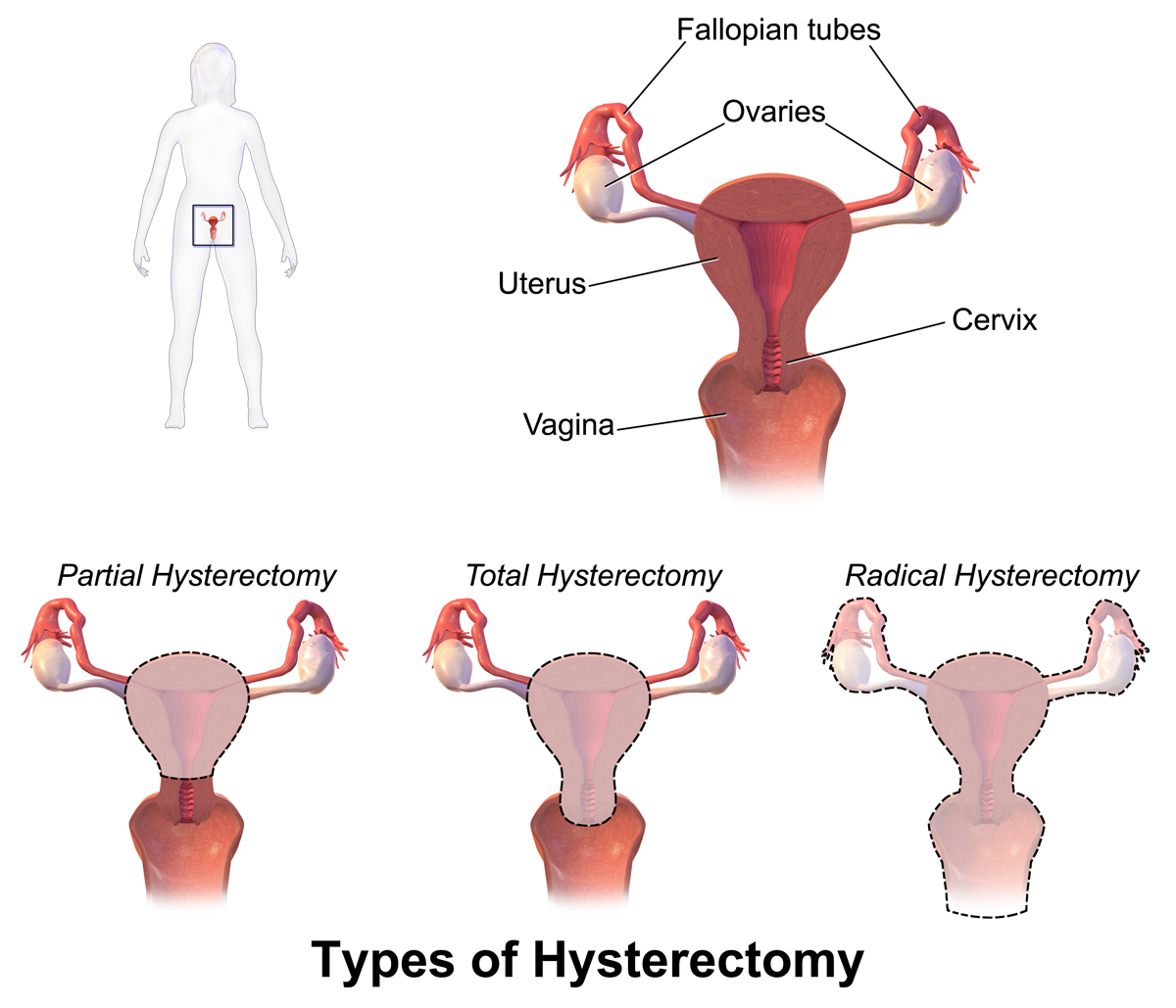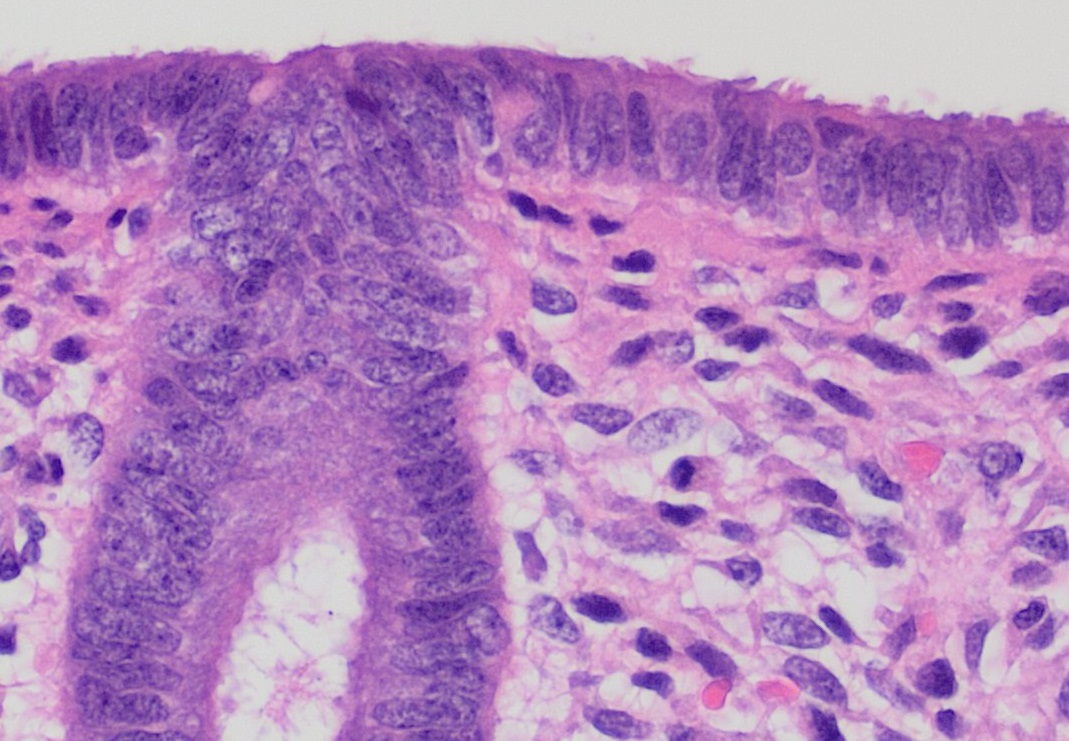|
Adenomyosis
Adenomyosis is a medical condition characterized by the growth of cells that proliferate on the inside of the uterus (endometrium) atypically located among the cells of the uterine wall (myometrium), as a result, thickening of the uterus occurs. As well as being misplaced in patients with this condition, endometrial tissue is completely functional. The tissue thickens, sheds and bleeds during every menstrual cycle. The condition is typically found in women between the ages of 35 and 50, but also affects younger women. Patients with adenomyosis often present with painful menses (dysmenorrhea), profuse menses (menorrhagia), or both. Other possible symptoms are dyspareunia, pain during sexual intercourse, chronic pelvic pain and irritation of the urinary bladder. In adenomyosis, ''basal'' endometrium penetrates into hyperplastic myometrial fibers. Unlike the functional layer, the basal layer does not undergo typical cyclic changes with the menstrual cycle. Adenomyosis may involve th ... [...More Info...] [...Related Items...] OR: [Wikipedia] [Google] [Baidu] |
Adenomyoma
Adenomyoma is a tumor (''-oma'') including components derived from glands (''adeno-'') and muscle (''-my-''). It is a type of complex and mixed tumor, and several variants have been described in the medical literature. Uterus, Uterine adenomyoma, the localized form of uterine adenomyosis, is a tumor composed of Endometrium, endometrial gland tissue and smooth muscle in the myometrium. Adenomyomas containing endometrial glands are also found outside of the uterus, most commonly on Adnexa of the uterus, the uterine adnexa but can also develop at distant sites outside of the pelvis. Gallbladder adenomyoma, the localized form of adenomyomatosis, is a Polyp (medicine), polypoid tumor in the gallbladder composed of Hyperplasia, hyperplastic Mucous membrane, mucosal epithelium and muscularis propria. Classification Uterine Adenomyoma Uterine adenomyoma is the focal form of uterine adenomyosis. Adenomyosis most commonly presents with numerous small collections of Endometrium, endometr ... [...More Info...] [...Related Items...] OR: [Wikipedia] [Google] [Baidu] |
Dysfunctional Uterine Bleeding
Abnormal uterine bleeding is vaginal bleeding from the uterus that is abnormally frequent, lasts excessively long, is heavier than normal, or is irregular. The term "dysfunctional uterine bleeding" was used when no underlying cause was present. Quality of life may be negatively affected. The underlying causes may be structural or non-structural and are classified in accordance with the FIGO system 1 & 2. Common causes include: Ovulation problems, fibroids, the lining of the uterus growing into the uterine wall, uterine polyps, underlying bleeding problems, side effects from birth control, or cancer. Susceptibility to each cause is often dependent on an individual's stage in life (''prepubescent, premenopausal, postmenopausal''). More than one category of causes may apply in an individual case. The first step in work-up is to rule out a tumor or pregnancy. Vaginal bleeding during pregnancy may be abnormal in certain circumstances. Please see Obstetrical bleeding and early ... [...More Info...] [...Related Items...] OR: [Wikipedia] [Google] [Baidu] |
Hysterectomy
Hysterectomy is the surgical removal of the uterus and cervix. Supracervical hysterectomy refers to removal of the uterus while the cervix is spared. These procedures may also involve removal of the ovaries (oophorectomy), fallopian tubes ( salpingectomy), and other surrounding structures. The term “partial” or “total” hysterectomy are lay-terms that incorrectly describe the addition or omission of oophorectomy at the time of hysterectomy. These procedures are usually performed by a gynecologist. Removal of the uterus is a form of sterilization, rendering the patient unable to bear children (as does removal of ovaries and fallopian tubes) and has surgical risks as well as long-term effects, so the surgery is normally recommended only when other treatment options are not available or have failed. It is the second most commonly performed gynecological surgical procedure, after cesarean section, in the United States. Nearly 68 percent were performed for conditions such as ... [...More Info...] [...Related Items...] OR: [Wikipedia] [Google] [Baidu] |
Endometrium
The endometrium is the inner epithelium, epithelial layer, along with its mucous membrane, of the mammalian uterus. It has a basal layer and a functional layer: the basal layer contains stem cells which regenerate the functional layer. The functional layer thickens and then is shed during menstruation in humans and some other mammals, including other apes, Old World monkeys, some species of bat, the elephant shrew and the Cairo spiny mouse. In most other mammals, the endometrium is reabsorbed in the estrous cycle. During pregnancy, the glands and blood vessels in the endometrium further increase in size and number. Vascular spaces fuse and become interconnected, forming the placenta, which supplies oxygen and nutrition to the embryo and fetus.Blue Histology - Female Reproductive System ... [...More Info...] [...Related Items...] OR: [Wikipedia] [Google] [Baidu] |
Menorrhagia
Heavy menstrual bleeding (HMB), previously known as menorrhagia or hematomunia, is a menstrual period with excessively heavy flow. It is a type of abnormal uterine bleeding (AUB). Abnormal uterine bleeding can be caused by structural abnormalities in the reproductive tract, skipping ovulation ( anovulation), bleeding disorders, hormonal issues (such as hypothyroidism) or cancer of the reproductive tract. Initial evaluation during diagnosis aims at determining pregnancy status, menopausal status, and the source of bleeding. One definition for diagnosing the condition is bleeding lasting more than 7 days or the loss of more than 80 mL of blood. Treatment depends on the cause, severity, and interference with quality of life. Initial treatments often involve birth control pills, tranexamic acid, danazol and hormonal intrauterine device. Painkillers ( NSAIDs) are also helpful. Surgery can be effective for those whose symptoms are not well-controlled with other treatments. App ... [...More Info...] [...Related Items...] OR: [Wikipedia] [Google] [Baidu] |
Uterine Fibroid
Uterine fibroids, also known as uterine leiomyomas, fibromyoma or fibroids, are benign smooth muscle tumors of the uterus, part of the female reproductive system. Most people with fibroids have no symptoms while others may have painful or heavy periods. If large enough, they may push on the bladder, causing a frequent need to urinate. They may also cause pain during penetrative sex or lower back pain. Someone can have one uterine fibroid or many. It is uncommon but possible that fibroids may make it difficult to become pregnant. The exact cause of uterine fibroids is unclear. However, fibroids run in families and appear to be partly determined by hormone levels. Risk factors include obesity and eating red meat. Diagnosis can be performed by pelvic examination or medical imaging. Treatment is typically not needed if there are no symptoms. NSAIDs, such as ibuprofen, and paracetamol (acetaminophen) may help with pain. According to The Mayo Clinic, NSAIDs may help relieve ... [...More Info...] [...Related Items...] OR: [Wikipedia] [Google] [Baidu] |
Menorrhagia
Heavy menstrual bleeding (HMB), previously known as menorrhagia or hematomunia, is a menstrual period with excessively heavy flow. It is a type of abnormal uterine bleeding (AUB). Abnormal uterine bleeding can be caused by structural abnormalities in the reproductive tract, skipping ovulation ( anovulation), bleeding disorders, hormonal issues (such as hypothyroidism) or cancer of the reproductive tract. Initial evaluation during diagnosis aims at determining pregnancy status, menopausal status, and the source of bleeding. One definition for diagnosing the condition is bleeding lasting more than 7 days or the loss of more than 80 mL of blood. Treatment depends on the cause, severity, and interference with quality of life. Initial treatments often involve birth control pills, tranexamic acid, danazol and hormonal intrauterine device. Painkillers ( NSAIDs) are also helpful. Surgery can be effective for those whose symptoms are not well-controlled with other treatments. App ... [...More Info...] [...Related Items...] OR: [Wikipedia] [Google] [Baidu] |
Gynecology
Gynaecology or gynecology (see American and British English spelling differences) is the area of medicine concerned with conditions affecting the Female reproductive system, female reproductive system. It is often paired with the field of obstetrics, which focuses on pregnancy and childbirth, thereby forming the combined area of obstetrics and gynaecology (OB-GYN). Gynaecology encompasses both Primary care, primary and Preventive healthcare, preventative care of issues related to female reproduction and sexual health, such as the uterus, vagina, fallopian tubes, ovaries, and breasts; subspecialties include family planning; minimally invasive surgery; pediatric and adolescent gynecology; and pelvic medicine and reconstructive surgery. While gynaecology has traditionally centered on Cisgender, cisgender women, it increasingly encompasses anyone with female organs, including transgender, intersex, and Non-binary gender, nonbinary individuals; however, many non-cis women face acce ... [...More Info...] [...Related Items...] OR: [Wikipedia] [Google] [Baidu] |
Endometrial Polyp
An endometrial polyp or uterine polyp is a tumor, mass in the inner lining of the uterus. They may have a large flat base (Sessility (medicine), sessile) or be attached to the uterus by an elongated wikt:pedicle, pedicle (pedunculated). Pedunculated polyps are more common than sessile ones. They range in size from a few millimeters to several centimeters. If pedunculated, they can protrude through the cervix into the vagina. Small blood vessels may be present, particularly in large polyps. Signs and symptoms They often cause no symptoms. Where they occur, symptoms include irregular menstrual bleeding, bleeding between menstrual periods, excessively heavy menstrual bleeding (menorrhagia), and vaginal bleeding after menopause. Bleeding from the blood vessels of the polyp contributes to an increase of blood loss during menstruation and blood "spotting" between menstrual periods, or after menopause. If the polyp protrudes through the cervix into the vagina, pain (dysmenorrhea) may ... [...More Info...] [...Related Items...] OR: [Wikipedia] [Google] [Baidu] |
Caesarean Section
Caesarean section, also known as C-section, cesarean, or caesarean delivery, is the Surgery, surgical procedure by which one or more babies are Childbirth, delivered through an incision in the mother's abdomen. It is often performed because vaginal delivery would put the mother or child at risk (of paralysis or even death). Reasons for the operation include, but are not limited to, obstructed labor, twin pregnancy, pre-eclampsia, high blood pressure in the mother, breech birth, shoulder presentation, and problems with the placenta or umbilical cord. A caesarean delivery may be performed based upon the shape of the mother's pelvis or history of a previous C-section. A trial of Vaginal birth after previous C-section, vaginal birth after C-section may be possible. The World Health Organization recommends that caesarean section be performed only when medically necessary. A C-section typically takes 45 minutes to an hour. It may be done with a spinal block, where the woman is awake ... [...More Info...] [...Related Items...] OR: [Wikipedia] [Google] [Baidu] |
Pregnancy Termination
Abortion is the early termination of a pregnancy by removal or expulsion of an embryo or fetus. Abortions that occur without intervention are known as miscarriages or "spontaneous abortions", and occur in roughly 30–40% of all pregnancies. Deliberate actions to end a pregnancy are called induced abortion, or less frequently "induced miscarriage". The unmodified word ''abortion'' generally refers to induced abortion. Common reasons for having an abortion are birth-timing and limiting family size. Other reasons include maternal health, an inability to afford a child, domestic violence, lack of support, feelings of being too young, wishing to complete an education or advance a career, or not being able or willing to raise a child conceived as a result of rape or incest. When done legally in industrialized societies, induced abortion is one of the safest procedures in medicine. Modern methods use medication or surgery for abortions. The drug mifepristone (aka RU-486) in c ... [...More Info...] [...Related Items...] OR: [Wikipedia] [Google] [Baidu] |








